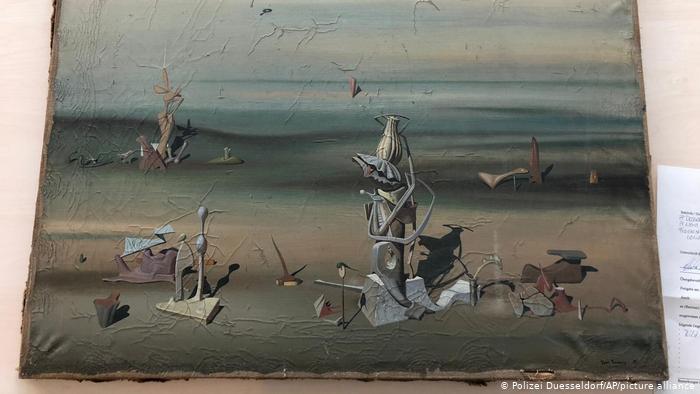Passengers leave behind about a million dollars a year at airport security checkpoints in the U.S. People leave their laptops behind on planes all the time. But this is genuinely something new to forget between the time a passenger entered one airport and when they left the next one: a $339,000 surrealist painting they meant to carry on their flight with them.
A businessman left behind the work by French painter Yves Tanguy at a check-in counter at the Dusseldorf airport in Germany before taking a flight to Tel Aviv on November 27. It was “packaged in a flat cardboard box.” The man didn’t realize he’d left it until he was in the air. On arrival he reached out to police in Dusselforf, but got nowhere.

Credit: Dusseldorf Police
The man’s nephew made the trip to the police station near the Dusseldorf airport to file a report. An officer spoke to the airport property manager and their cleaning company. The paining was found at the bottom of a paper recycling bin.
This week the owner of the painting got it back. Lost items frequently stay lost which is a huge airline failure. Getting such a valuable item back seems so improbable that the story is now even confirmed at Snopes.com.
A businessman accidentally left behind the painting by French surrealist Yves Tanguy at a check-in counter as he boarded a flight from Duesseldorf to Tel Aviv. https://t.co/5MGC9HNOs3
— snopes.com (@snopes) December 10, 2020
(HT: Paul H.)


What a moron!
There you go again , Gary, writing click-bait that has nothing to do the subject matter of this blog. I honestly don’t know how your staff of 35 can’t come up with better material than re-hashing Snopes
Cross-border transport of high-value artwork is one of the prime money laundering methods used by the wealthy to move and hide large amounts of ill-gotten gains. That and shady real estate transactions. Anonymous shell corporations being engaged in questionable business to business transactions is also part of that picture, but that’s actually way more tightly monitored — and under increasingly closer government scrutiny — than the use of art and even precious gems for money laundering and tax evasion purposes.
I think Gary has a valid point – lost and found in airports does not work even in Germany.
But JAL cabin crews are great. Few years ago, we flew NRT-BKK and my wife left her beach straw hat in an overhead bin. Two week later after traveling through South East Asia we were checking in with JAL in BKK on an early morning. The agent looked into a computer, asked if we would wait a minute, and returned with the hat!
Actually Gary, I like this story. I read it somewhere when it came out and I was amazed. Now you have a picture of the man with the actual picture. Nice. My then 20 year old daughter once left her wallet on a United Flight when she got off at Dulles. She was beside herself. We called United and they actually called ahead to another airport where the plane was landing. They did a search of the plane and found her wallet and got it returned. Hard to believe. And her money and other things were in the wallet!
Who was the moron who threw it out instead of putting it in ‘lost and found’?
About 10 years ago, my brother lost his wallet on an IB flight to the depths of the seat in J. He didn’t notice until later. On his trip back he got the same aircraft, and though the crew laughed at letting him check… there it was, a week later.
Kind of reminds me of the story when the Richard B. Russell building in Atlanta was remodeled. The cleaning crew there found a dropcloth that was left in the building and threw it away. Turns out the “dropcloth” was actually a painting that cost the government somewhere in the neighborhood of $100K to purchase. Apparently, the artist was very upset, though I have to ask, if people can’t tell the difference between a dropcloth and a work of fine art, is that not an indictment on the artist instead of the people?